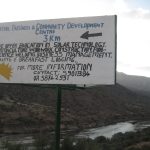
This gallery contains 1 photo.

This gallery contains 1 photo.

This gallery contains 1 photo.

This gallery contains 1 photo.

This gallery contains 1 photo.

This gallery contains 1 photo.

This gallery contains 1 photo.

This gallery contains 1 photo.
Public art is the medium which democratizes the process of manufacturing an urban landscape. Buildings are the city’s trees, and the mural is raw exposure to the ecology of the urban population. Nowhere else is the process of community design more inclusive. The murals in study were created by youth in two Boston low-income communities of color. By allowing this type of participation in the city, these youth can create places for themselves in a society that often tells them there is no place for them. Public art allows communities to reflect who they are. They exist as artifacts of cultural identity. Sometimes public art is forgotten, or even painted over. This is why public art so often lends itself to community participation. It is a medium that allows for changes in the community identity. We tend to enjoy murals and other forms of public art because they add character and evidence of who lives in the community. The author argues that public art is a form of community design participation that is implementable in all communities. Further, those communities that enact legislation (design standards) that prohibit this kind of public art aim to prohibit active participation in the community.
Often cities under the global spotlight use their landscape as a stage. The idea of a living performance is unique and at times problematic. We see this every other year with the winter and summer Olympics. Cities spend years working to prepare their city as all eyes will be on how well they can “perform”. In this article, author Anne Rademacher puts Kathmandu under a microscope. Soon after the state of Nepal declared a state of emergency, it had to host many South Asian countries for a major trade conference. Within days, many dilapidated housing complexes were leveled and new urban parks rapidly created. As with the Olympics, the long-term implications of the performance landscape after the performance has ended can often leave cities with inefficient and a landscape that is too-purpose built to be sustainable. This is not just a problem Kathmandu faces, but Kathmandu’s unique status as a place in need creates a unique problem. Globalization, in this instance, forced Kathmandu to compete with other global cities. In reality, the city is not on the scale of other global cities and normally, wouldn’t have to compete with the resource-privileged communities around the world. In fact, in a time when resources were strained, they had to be diverted away from crisis-alleviation and instead to meeting the demands of a global society.
In Palermo, Italy, the farmers’ market is the premiere social institution and exists as the intersection of the between political, economic, and environmental participation of its residents. The history of the market is carefully woven into the rich narrative of the community. Often the market has been a microcosm of events happening throughout the region. Changes in economic and social principles that occurred in the 20th century were girded by the fundamental principles of the market. Grassroots activism is central to Palermo’s culture. Civic participation is relatively high, as is the need to preserve the sustainable market that has existed in the city for centuries. Palermo benefits from being on a island (Sicily) and having access to a rich ecology leading to a diverse native diet. As Palermo’s residents discovered, the mobilization of consumers, while often intentionally degraded, represents a powerful force. These grassroots activists were able to preserve its integrity and very existence after it was threatened by an anti-institutional municipal government. For Palermo, the world may change, but the market will always exist as the beating heart of the community.
The growth of the Caribbean tourism industry has lead to a changing landscape. New urban centers are emerging as a new type of development. These urban centers are not dense with budding Caribbean populations but exist only as concentrated areas of tourism development. On any given day, the population of the area is made up of a high demographic of tourists, sometimes even more tourists than locals. This is true for many tourist centers around the world. These tourist centers emerge as demand increases for particular areas. The days of an area anchored by a single resort have passed. The creation of these resort towns which concentrate tourism into internationally-recognized places is causing a shift in the landscape. These are urban landscapes built not for growing populations but for growing tourism. Having an urban landscape dictated by an inherently transient population neglects the rich anthropology of the local people. These landscapes no longer reflect the culture of the place but rather, what the place is advertised to be. Author Amelia Moore argues that a greater incorporation of culturally- and naturally-dictated design and a respect for urban anthropology should be prioritized over the growth of the tourism industry. Failure to do so will deteriorate the sustainability of the region.
The metrics of sustainable living are highly contested among Swedes. This is the argument that ethnographer Cindy Isenhour argues in her piece, Imaginings and Practices of Sustainable Living in Sweden. The rift exists between those that subscribe to a quantitative metric of lifestyle evaluation and those that subscribe to a qualitative metric. Quantitative metrics are popular as they allow a technical understanding which is often more approachable and respected by the industrial and academic class which dominates urban society. Qualitative metrics allow for a sometimes unexplainable, almost inane connection to the natural landscape that cannot be measured or calculated. A popular belief exists in Stockholm and many western urban centers that urban living is more sustainable as, on paper, it has a smaller carbon footprint. This is based in the fact that often resources are more dense and well connected by multiple modes of transportation. This dense landscape results in a dense lifestyle. Rural Swedes argue that a sustainable lifestyle is one with a more direct connection to the natural landscape. Rural Swedish lifestyles are less dense but qualitatively more sustainable. However, there are several key principles that unite the quantitatively- and qualitatively-sustainable lifestyles. These are principles deep ingrained in Scandinavian culture. The idea of global equity and equal claim to the environment (land) are constitutional and inalienable rights. Both urban and rural dwellers have a merited claim to an open and healthy natural landscape.
Demaria et al.’s argument hinges itself on the concept of degrowth, an anti-utilitarian form of development. This concept has garnered quite the following as cities and nations around the world have begun to adopt the degrowth concept. Communities that adopt degrowth aim to retroactively eliminate inefficient development and return landscapes back to their natural aesthetic. Degrowth is seen as a more workable solution to those who feel that the world has grown too quickly and left too many behind. Those behind the degrowth thinking believe that a reduction in development will improve democracy, justice, and environmental conservation. However, growth is a reality that we are all facing as a human populous and failure to create the proper infrastructure for growth will not limit growth but rather reduce the quality of life in times of an exponentially increasing population. If degrowth is to continue, it must exist in the form of responsible growth that eliminates the impact of development. Degrowth should not be seen as a retaliation against all growth. Rather degrowth seeks to transform growth metrics away from quantity but rather into metrics of quality. Development which has many costs should not increase in size and shape like many of the urban areas of the last century, but should be seen as an evolution, increasing the quality of life for community members and the quality of the local landscape.
Martha Honey’s critical analysis of the ecotourism industry identifies a rift in the two forms of ecotourism. As she refers to them, there exists: sound ecotourism and ecotourism lite. This is another form of greenwashing, as is common across many industries. The goal of ecotourism, according to trade definitions, is transform tourist experiences beyond the traditionally wasteful leisure behaviors and use high-impact experiences to increasing conservation awareness. To do so, sound ecotourism experiences should take into account all of the aspects of tourism and not limit them to minor decisions that lack a concentrated effort. The discussion about ecotourism remains an unresolved dispute whose relevance remains poignant. Some countries are becoming mono-industrial, developing economies around a single industry, in this case eco-tourism, which can have dangerous effects economically. Environmentally however, these countries are more motivated to participate in conservation efforts because they have a bigger stake in the game. The degradation of their natural environment would result in declines in their ecotourism industries, limiting their growth and prosperity to that of the environment.
Libby Robin’s Australian perspective on the discipline of ecology reminds readers that the role of ecologists around the world varies. The perception of the discipline of ecology as a whole is seen as a “subset” of other natural sciences. Most ecologists are employed by the government, rather than research institutions or private corporations, like in the US. However like the US, the culture has come to rely on ecology only in times of despair, when it is easy, but has faced challenges accepting the findings of ecology when they go against other goals such as national development. When it came to Australia’s environmental movement, the common people generally supported bringing conservation scientists into the discussion to speak on their behalf against large development schemes or organizations. These scientists began to organize and voice uniform opinions based on homogenous consensus. The general population, after the successes of conservation scientists, accepted the role of scientists to speak on behalf of nature. This set up the modern discipline of applied ecology in Australia. However, the identity of ecologist, since it is created by the culture at-large, is subject to at-large interpretation. When the new green movement that sought to move away from hard science was lumped together with ecology, conservation scientists were forced to distinguish themselves. While both groups had the same goals, they differed in their intentions and if ecology was to remain the prominent voice in conservation, it had to stand by its scientific roots.
The disconnect between learned science and understood science is the subject of Checker’s piece. Learned science is owned by the camp of “experts” those with the universally accepted credentials to evaluate an environment. Understood science is owned by the community members that observe changes in their environment. The research method of learned science fixates on a particular observation and is pigeonholed into a specific area of study which limits the range of interpretation of phenomena. The research method of understood science is based in the observation of the entire environment, without identifying control or variables. One would argue that the camp of understood science would produce the better scientific understanding. However, the inability to translate observations into an analytical understanding that can be evaluated in a causal manner gives power to the learned science discipline. In the case of Checker’s research, residents of Hyde Park are in the understood science camp and EPA scientists are of the learned science. Because learned science has the power and is unable to reach the same conclusions as understood science, they believe there is no environmental problem. However, the observations of understood science are valid. The elimination of the disconnect between trained and citizen scientists or rather, increased collaboration and understanding between the two would lead to a more holistic understanding that would prevent the marginalization of communities that are not represented by the discipline of trained science.
Observation in the social sciences is based on a diverse library of perspectives. These perspectives are unique and separate but sometimes build off of one another. In an ideal world, the perfect social scientists would have an precise knowledge of all perspectives and be able to apply them unbiasedly across their research. Instead, social scientists often rely on a select few perspectives, often based on their own experiences. In the study of human-environment relations, there are a subset of perspectives. The association with gender and the environment is more broadly the culture/nature divide. Nightingale’s perspective on the differences in connections to the environment between genders are explained in a singular sense. This is done simply to introduce the idea to the reader. The author understands that in practice, a web of intersectionalities exist to create complex and unique circumstances. As social scientists, we should understand the same. The best social scientists are able to discern the perspectives and apply them precisely. By not putting too much weight on any single perspective yet also valuing the perspectives equally, you can recognize and piece together the puzzle that is each actor’s motivation. Gender and greater social and cultural institutions should not be an archetype to predict behavior but rather a motivator. Culture as an environment, in this case, dictates relationships between organisms. Gender is the defining characteristic of the human gender, and it is fluid, like climate, nature’s defining characteristic.
Edelman’s piece identifies international agriculturalists as an actor in the global environmental politics stage. With a lack of resources or formal recognition, government agencies have sprung up to speak on behalf of their livelihood. In the past few decades, these international agriculturalists, farmers that export surplus to other countries, have organized and mobilized to force themselves into the discussion. Sometimes this is accomplished by disrupting talks by agencies such as the WTO (formerly GATT) and other times they host their own talks to strengthen the bond of their community. The organization of these farmers, Via Campesina, is a heterogeneous organization made up of members from over 50 countries. This diversity does create some issues as naturally not everyone has the same goals. The organization recognized this early on and decided that instead of trying to homogenize ideology, they should focus on organizing and mobilizing so that the farmers in their position have a louder and more prominent voice in the discussion. This type of interaction represents a common pattern in citizen roles of environmental politics. Often citizens need to organize together to make a concentrated impact but goals and ideology are not always homogenous. The coalition model is more effective than the collective model because it allows for a rigid diversity that can withstand occasional differences in opinion but results in a net positive impact.